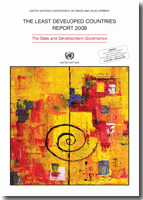
| Developed countries | US$ 50 |
| Developing countries | US$ 25 |
| Least Developed Countries | US$ 12.50 |
The global crisis has undermined the factors that enabled strong GDP growth performance in LDCs in 2002-2008, exposing once again both the lingering structural weaknesses of their economies, and the myth of self-regulating markets.
The shortcomings of the current development paradigm need to be addressed. A rebalancing between the State and the market is necessary to create resilience to external shocks through greater diversification and structural change, and to promote a more inclusive and employment-intensive growth path. LDCs need to build new developmental States that seriously attempt to deploy their administrative and political resources to the task of economic development. LDCs need to find new forms of development governance that are appropriate for the twenty-first century.
From a macroeconomic point of view, the key challenge for LDCs is to mobilize the much-needed financial resources. Public investment should be undertaken to close the infrastructure gap and "crowd in" private funds for faster capital accumulation. Monetary policy should sustain such a pro-investment macroeconomic framework, instead of focusing on tight inflation targeting and thereby hampering long-term investment. Active exchange rate and capital flow policies should also support the expansion of productive capacities, by reducing exchange rate volatility and preventing capital flight. LDCs also need to strengthen domestic financial institutions, recognizing their important role in supporting private investment and mobilizing savings.
LDCs are currently in a vicious circle of deficient food production, subsistence agriculture, low levels of productivity, declining investment, increasing scarcity of land and water, and rising rates of urbanization. LDCs should give much greater priority in government policy to agriculture. They should boost agricultural investment, fostering the uptake of new technology, developing infrastructure (e.g. roads, warehouses and wholesale facilities), and improving access to credit, particularly for small-scale and medium-scale farmers. Governments also need to take measures that favour access for small-scale farmers to improved inputs, that support agricultural research and development, and that spread knowledge about effective farming and farm management.
Despite their recent strong growth performance, few LDCs have managed to spur structural change and pursue a sustainable diversification of their economies, while many have actually experienced de-industrialization. Improvements in the economic performance of LDCs will require effective industrial policy that includes public investment and strategic coordination of private actors. Simultaneous efforts to raise investment levels, build new economic links, and upgrade technological capacity - which is at the heart of industrial growth - are the surest ways of promoting diversification and economic growth in LDCs.


